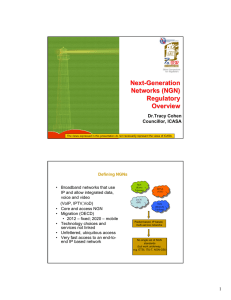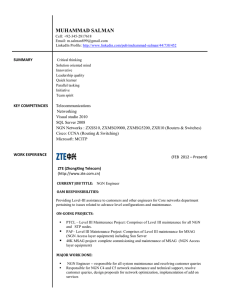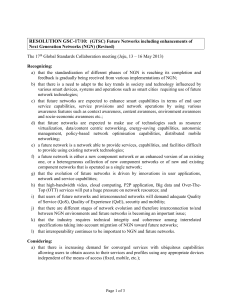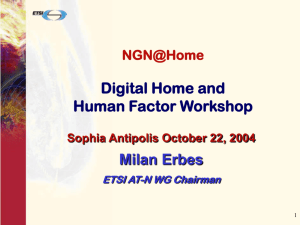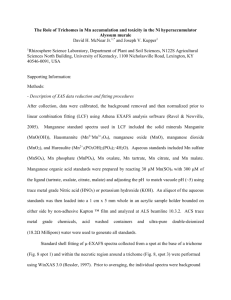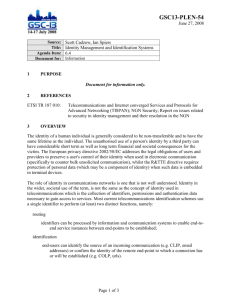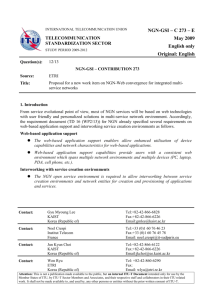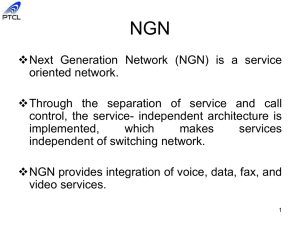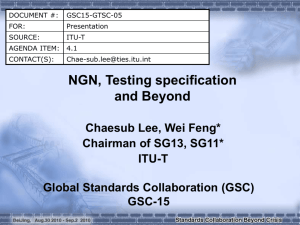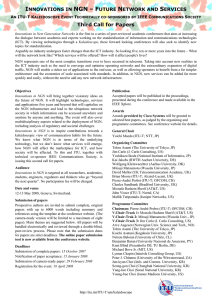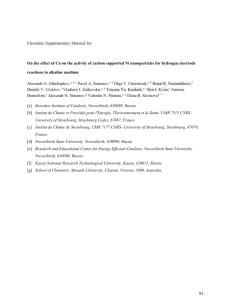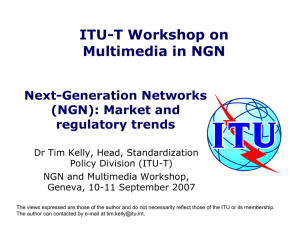DC Power Supply
advertisement
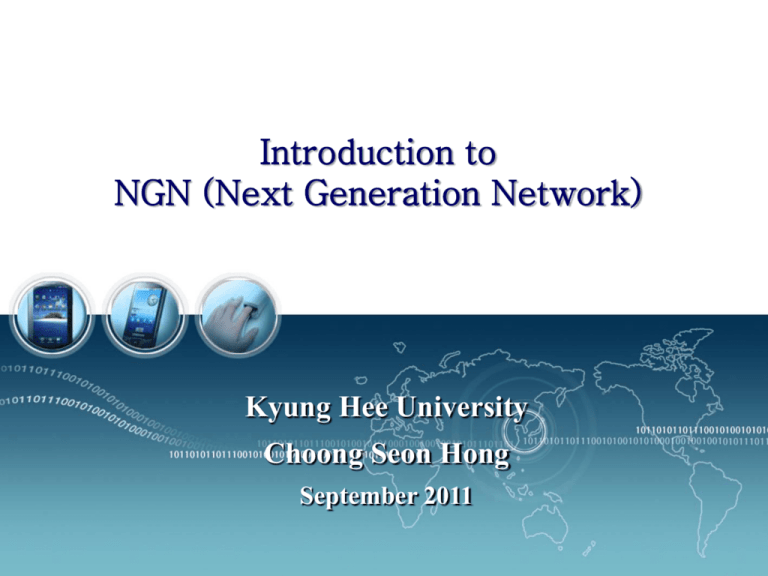
Introduction to NGN (Next Generation Network) Kyung Hee University Choong Seon Hong September 2011 Objectives Explore technical, operational and commercial issues overlaps Numbering, interconnection, quality Backbone and transit options Migration and roll-out of new services Retail and interconnection charging models 2 Two Big Streams ITU ? IETF ITU : International Telecommunication Union IETF : Internet Engineering Task Force 3 The changed market Common network technology - IP Diverse access technologies - xDSL, WiFi, WiMax, CDMA, LTE, self managing radio New management concepts - user provided services, self configuring networks Liberalisation - anyone can do almost anything Network competition - telcos vs Internet Market is out of “control” NGN is subject to “uncontrolled” market forces Users have real diverse choices 4 Telecommunication Network Transformation • As strong drivers transform the telecom business model, CTO‘s are facing significant challenges; Implications of the transformation of a Legacy Network towards NGN Drivers of Network Transformation NGN Model Legacy Network Model ■ Strong Competition in the Telecom market Place Services ■ Trend towards converged services ■ Integrated Services (Quadruple Play) ■ Differentiated Services Technology ■ Obsolescence of TDM Technology ■ Open Architectures ■ New Access Technologies ■ New Terminal Devices Move to NGN: from a vertically layered to a horizontally layered network architecture Services, Switching, Network Mgmt. PSTN Data PLMN Services & Applications Open Protocols e.g.. Parlay, OSA, JAIN Call / Session Control Open Protocols e.g.. SIP, MGCP, H.248 Transmission / Transport Transport & Connectivity Network Management, Business support layer, enabling capabilities Market/Customers Impact of Network Transformation n Business model must be reviewed and adjusted Platforms/Production n Operations and business processes must be changed ■ Limited growth with legacy NW ■ Increased OPEX for legacy NW ■ Emerging Vendors n Organization structure must be adapted n Human resources profile must be adjusted PLMN: Public Land Mobile Network 5 The effect of real competition Innovation is accelerating, eg Voice over Internet, public WiFi, xDSL, TV over telephone wires Growing pressure on excessive prices Usage based charges are disappearing Battle between telco complexity and Internet simplicity 6 Critical issues for NGN Copy past telco models and practices or develop new simpler ones? - Who is studying new simpler models? What will be the new services that will justify new investment? What will users pay for that is not available more cheaply on the Internet? - quality? security? Who will be the leaders? Incumbents? Will regulation, eg interconnection structures, be a barrier to development? 7 Migration paths - replacement Analog/ISDN UNIs IP-based UNIs PSTN on IP Core PSTN Circuit switched core IP core New services on IP Core NGN Other Telephony over xDSL Voice over Internet ? TV over xDSL “Plain old Internet” Home Gateway 8 Migration paths - overlay Analog/ISDN UNIs IP-based UNIs PSTN PSTN on IP Core Circuit switched core IP core overlay IP core New services on IP Core NGN Other ? Voice over Internet Telephony over xDSL TV over xDSL “Plain old Internet” Home Gateway 9 Replacement and protocols Analog/ISDN UNIs IP-based UNIs Emulation PSTN Circuit switched core IP non-IMS core ? IMS or non-IMS core ??? New services on IP Core IMS core …and which protocol at interconnection points (SIP-I/T or SIP-IMS)? …how many stages of migration (2 or 3)? The Session Initiation Protocol (SIP) is a signaling protocol, widely used for controlling multimedia communication sessions such as voice and video calls over Internet Protocol (IP). IMS : IP Multimedia Subsystem 10 IMS (IP Multimedia Subsystem) 11 11 What new services? With terminal liberalisation, networks only provide packet pipes - should packet pipes be standardised to make interconnection easy? The focus on service capabilities is drawing attention away from the need to develop new services with terminals 12 NGN Services • Analyze Current, Planned, and Future Telecommunications Services for the NGN infrastructure Transport QoS Presence PSTN Access IT Capabilities Sensory Interfaces Web Portal 1st Stage Clustering 3rd Party Delivery Transport Predictability 2nd Stage Clustering Predictability & Broadcast Network Services Audio n n n n n Telephony Telephone Conference VoIP (e.g. Skype) Audio Streaming Audio on Demand/ Download 3rd Stage Clustering IT Billing, Security.. Audio-Visual Core Services n n n n n Video Phone Video Phone Conference Video on-Demand Video Download Video Sharing Visual n n n Web Page Video Supervision Web Camera IPTV Data n n n n Data on Demand Data Sharing Data Streaming/ Broadcasting Data Conferencing(Gaming) 13 Dimensioning NGN What traffic will it carry ? Telephony Video-telephony TV and radio delivery ? Email ? Web browsing ? Internet access traffic ? Why put any non-delay sensitive traffic on NGN? 14 Introduction to Future Internet History of Internet Growth (1) Stage One: Research and Academic Focus (1980-1991) Debate about which protocols will be used (TCP/IP) The National Science Foundation (NSF) took a leading role in research networking NSFNet1: “supercomputer net” NSFNet2: a generalized Internet (thousands of Internet nodes on U.S campus) The Internet Engineering Task Force (IETF) created open standards for the use of the Internet Request for Comments (RFC) standards documents 16 History of Internet Growth (2) Stage Two: Early Public Internet (1992-1997) Federal Networking Council (FNC) made a decision to allow ISP to interconnect with federally supported Internets The National Center for Supercomputing Applications (NCSA) adopted Tim Berners-Lee’s work on the World Wide Web Mosaic, Netscape started us down the path to the browser environment today It was watershed development that shifted the Internet from a command-line, e-mail, and file-transfer in the kind of user interface to the browser world of full-screen applications In the fall of 1996, a group of more than thirty University Corporation for Advanced Internet Development (UCAID) Subsequently become known as Internet2 17 History of Internet Growth (3) Stage Three: International Public Internet (1998-2005) The Internet achieved both domestic and international critical mass of growth Fueled by giant bubble in Internet stocks that peaked in 2000 and then collapsed Fiber-optic bandwidth Improvements to gigabit-per-second levels, and price-performance improvements in personal computers xDSL, FTTH, etc. The “bubble” years laid the foundation for broadband Internet applications and integration of voice, data, and video services on one network base 18 History of Internet Growth (4) Stage Four: Challenges for the Future Internet (2006-?) The Internet has become a maturing, worldwide, universal network Recently debated policy issues: net neutrality Two of the few surviving U.S. telcos intended to levy special surcharges on broadband Internet traffic based on the application and on the company Millions of Internet users • Growth in functionality and value of the net could never happened if there had been discrimination in managing packet flow If the telco’s well funded campaign succeeds Then Progress toward universal and affordable broadband access would be further delayed 19 Recall of Internet (’74) Design Goals (0) To connect existing networks (1) Survivability (2) To support multiple types of services (3) To accommodates a variety of physical networks (4) To allow distribute network management (5) To be cost effective (6) To allow host attachment with a low level of effort (7) To allow resource accountability Design Principles Layering (design goal – 0, 3) Packet Switching (design goal – 5) A network of collaborating networks (design goal – 1, 4) Intelligent end-system / end-to-end arguments (design goal – 1, 5) DHCP (design goal – 6), SNMP (design goal – 7) 20 Changes of Networking Environment Trusted => Untrusted Users Researchers => Customers Operators Nonprofits => Commercial Usages Host-oriented => Data-centric Connectivity E2E IP => Intermittent Connection 21 Assumptions Incremental Design A system is moved from one state to another with incremental patches How should the Internet look tomorrow ? IETF and IPv6 perspective Clean-Slate Design The system is re-designed from scratch How should the Internet look in 15 year ? Future Internet It is assumed that the current IP’s shortcomings will not be resolved by conventional incremental and “backwardcompatible” style designs. So, the Future Internet designs must be made based on clean-slate approach. 22 Problem Statement (1/4) 1. Basic Problems 1.1. Routing Failures and scalability The problems have been examined as being caused by mobility, multi-homing, renumbering, PI routing, IPv6 impact, etc. on the current Internet architecture. 1.2. Insecurity As current communication is not trusted, problems are self-evident, such as the plague of security breaches, spread of worms, and denial of service attacks. 1.3. Mobility Current IP technologies was designed for hosts in fixed locations, and ill-suited to support mobile hosts. Mobile IP was designed to support host mobility, but Mobile IP has problems on update latency, signaling overhead, location privacy, etc. 23 Problem Statement (2/4) 1.4. Quality of Service Internet architecture is not enough to support quality of service from user or application perspective. It is still unclear how and where to integrate different levels of quality of service in the architecture. 1.5. Heterogeneous Physical Layers and Applications Recently, IP architecture is known as a “narrow waist or thin waist”. Physical Layers and Applications heterogeneity poses tremendous challenges for network architecture, resource allocation, reliable transport, context-awareness, re-configurability, and security. 1.6. Network Management The original Internet lacks in management plane. Narrow Waist for Internet Hourglass (Common Layer = IP) Source : Steve Deering, IPv6 :addressing the future 24 Problem Statement (3/4) 1.7. Congestive Collapse Current TCP is showing its limits in insufficient dynamic range to handle high-speed wide-area networks, poor performance over links with unpredictable characteristics, such as some forms of wireless link, poor latency characteristics for competing real-time flows, etc. 1.8 Opportunistic and Fast Long-Distance Networks Original Internet was designed to support always-on connectivity, short delay, symmetric data rate and low error rate communications, but many evolving and challenged networks do not confirm to this design philosophy. E.g., Intermittent connectivity, long or variable delay, asymmetric data rates, high error rates, fast long-distance communications, etc. 1.9. Economy and Policy The current Internet lacks explicit economic primitives. There is a question of how network provider and ISP continue to make profit. 25 What is Future Internet? (1) Need to resolve the challenges facing today’s Internet by rethinking the fundamental assumptions and design decisions underlying its current architecture Two principal ways in which to evolve or change a system Evolutionary approach (Incremental) A system is moved from one state to another with incremental patches Revolutionary approach (Clean-slate) The system is redesigned from scratch to offer improved abstractions and/or performance, while providing similar functionality based on new core principles It is time to explore a clean-slate approach In the past 30 years, the Internet has been very successful using an incremental approach Reaching a point where people are unwilling or unable to experiment on the current architecture 26 What is Future Internet? (2) Future Internet? Clean Slate design of the Internet’s architecture to satisfy the growing demands Management issues of Future Internet also need to be considered from the stage of design Research Goal for Future Internet Performing research for Future Internet and designing new network architectures Building an experimental facility 27 Merits & Demerits of Current Internet Merits The original Internet design goal of robustness Network architecture must not mandate recovery from multiple failures, but provide the service for those users who require it Openness: low barrier to entry, freedom of expression, and ubiquitous access Demerits “Nothing wrong – just not enough right” Pervasive and diversified nature of network applications require many functionalities Current network architecture doesn’t support E.g., TCP variants for high bandwidth delay product networks, earlier work on TCP over wireless networks, and current effort towards cross-layer optimization 28 Research Institute for Future Internet (1) US NSF Future Internet Design (FIND) Global Environment for Networking Innovations (GENI) European Commission Future Internet Research and Experimentation (FIRE) EIFFEL’s Future Internet Initiative EuroNGI & EuroFGI FP7 29 Research Institute for Future Internet(2) AsiaFI by CJK China : NSFC & MOST 973 Fundamental Research Project MOST 863 High-tech Project CNGI Project JAPAN NICT’s NeW Generation Network (NWGN) Japan Gigabit Network II (JGN2) AKARI Project KOREA Future Internet Forum (FIF) 30 Sensor Network in the Future Internet and NGN Environments - Layers in the Ubiquitous Sensor Networks 31 Thinking and Execution!! 32 Thank you ! Q&A
